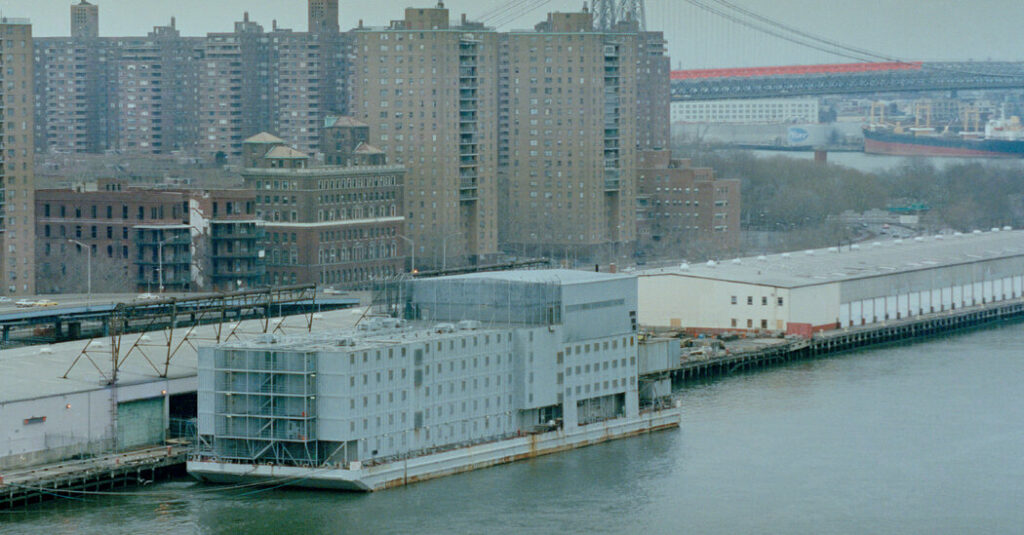EMPTY VESSEL: The Story of the Global Economy in One Barge, by Ian Kumekawa
Container ships are designed to be blandly functional. Gigantic metal platforms, they chug along from port to port and are habitually taken for granted — until, that is, they run aground on the jagged rocks of catastrophe.
When the pandemic arrived five years ago, Americans who were trying in vain to procure protective gear like face masks got an unwanted lesson in the intricacies of global supply chains. Today, in the wake of Trump’s tariffs, including a whopping 145 percent on China, the exact locations of container ships have become a matter of grim fascination. Over the last couple of weeks, social media users have been posting live maps of cargo traffic as if on hurricane watch.
“Normally, the physical dimension of globalization remains in the background, relatively unnoticed,” Ian Kumekawa writes in his new book, “Empty Vessel.” A historian at Harvard, he realized that one way to make the abstract workings of the global economy more concrete would be to tether them to something you could touch. The “empty vessel” of his title is a barge made of steel that weighs 9,500 deadweight tons. It has served as a “floatel” for oil rig workers, a barracks for British soldiers, a jail for New York City inmates, among other things. Like Zelig, it adapted to whatever it was expected to be: “Its emptiness has been its defining characteristic.”
This elegant and enlightening book is an impressive feat, especially given that its main character is, as Kumekawa admits, stubbornly uncharismatic: “a dumb pontoon without voice, personality or drive.” Constructed in a Swedish shipyard in 1979, the vessel and its sister ship were container barges built too late to carry actual cargo. Western countries like Sweden and the United States had already entered an era of industrial decline. Shipping capacity began to outstrip demand in the early 1970s. Then the oil crisis hit. “We used to make things here” became a familiar refrain.
And so Kumekawa gives us a “barge’s-eye view” of what his protagonist witnessed over the ensuing decades, tracing how the vessel became a passive yet essential participant in a rapidly changing world. “Empty Vessel” joins a growing shelf of books about the new forms that globalization is taking, including Atossa Araxia Abrahamian’s “The Hidden Globe” and Quinn Slobodian’s “Crack-Up Capitalism.” They all detail efforts by the rich to offshore their wealth and escape constraints of national sovereignty. But abstractions like “financialization” and “deregulation” still rely on underlying assets, which is to say, on material reality. Kumekawa sees his book as “a guide to how major global transformations were always embodied, grounded in tangible things and, often, dependent on physical violence.”
The vessel’s connection to violence was forged early on. Shipbuilding is a dangerous job. Kumekawa describes how Sweden’s Finnboda, which had been building ships since the mid-19th century, still had its share of workplace accidents when it constructed the vessel and its sister. Workers were routinely exposed to asbestos and lead paint. Hearing loss was common. Iron chips were frequently removed from workers’ eyes.
Delivered to a Norwegian company, the vessel was initially put to work in the North Sea. There, it could make money by working in the oil fields or carrying dredged-up scraps of German warships. But its ultimate purpose was to give its Norwegian investors, who could write off their investments in shipping, a legal way to circumvent paying taxes: “Arguably, it was worth more as a financial abstraction than as a concrete, working ship.”
Kumekawa follows the vessel and its sister through their various names and incarnations. In 1982, Argentina’s military junta invaded Britain’s Falkland Islands, and the vessels — registered in the U.K. and rechristened the Safe Esperia and the Safe Dominia — were sent to the South Atlantic to house British soldiers. But it wasn’t the state that acquired the vessels; it was a private shipping company called Bibby Line. Margaret Thatcher’s conservative government had struck an “uneasy bargain” between “globalism and nationalism,” Kumekawa says, promoting privatization with one hand and delivering “patriotic flag-waving” with the other.
The vessel would go on to be a silent player in West Germany’s automotive industry (as temporary housing for Volkswagen’s trainees) and the growth of mass incarceration in the United States (as a floating jail at Pier 36 in Manhattan). By that time, Bibby Line had re-registered the ship so that it flew the Bahamian flag. The company’s British owner, Derek Bibby, presented this “reflagging” as a matter of “economic necessity.” Flying a “flag of convenience” from a country like the Bahamas or Liberia gave wealthy investors the benefit of lower taxes and laxer laws. It was all “very sad,” Bibby said, “but we must not let our feelings govern our activities.”
So much for rallying around the Union Jack during the Falklands War. The irony is not lost on Kumekawa, who calls flags of convenience “markers of globalization par excellence.” For moneyed interests trying to profit from a world in flux, such flexibility is useful. The vessel and its sister were similarly pliable: “They were adaptable Band-Aids, not bespoke, individualized treatments. This is why the vessel was especially valuable during crises.”
But the vessel still had to be maintained and cleaned, staffed and tended to. Kumekawa has written a book about a boat, but he wants us to bear in mind the human beings it carried. By 2018, the sister ship was stranded in Walvis Bay, Namibia, one of several boats that had been abandoned by their parent company, Halani Shipping. They were registered in St. Vincent and the Grenadines. An Indian crew of eight was stuck without pay off the coast of Africa for more than nine months. “They had been forsaken in a world of little oversight and even less responsibility.”
EMPTY VESSEL: The Story of the Global Economy in One Barge | By Ian Kumekawa | Knopf | 304 pp. | $29
